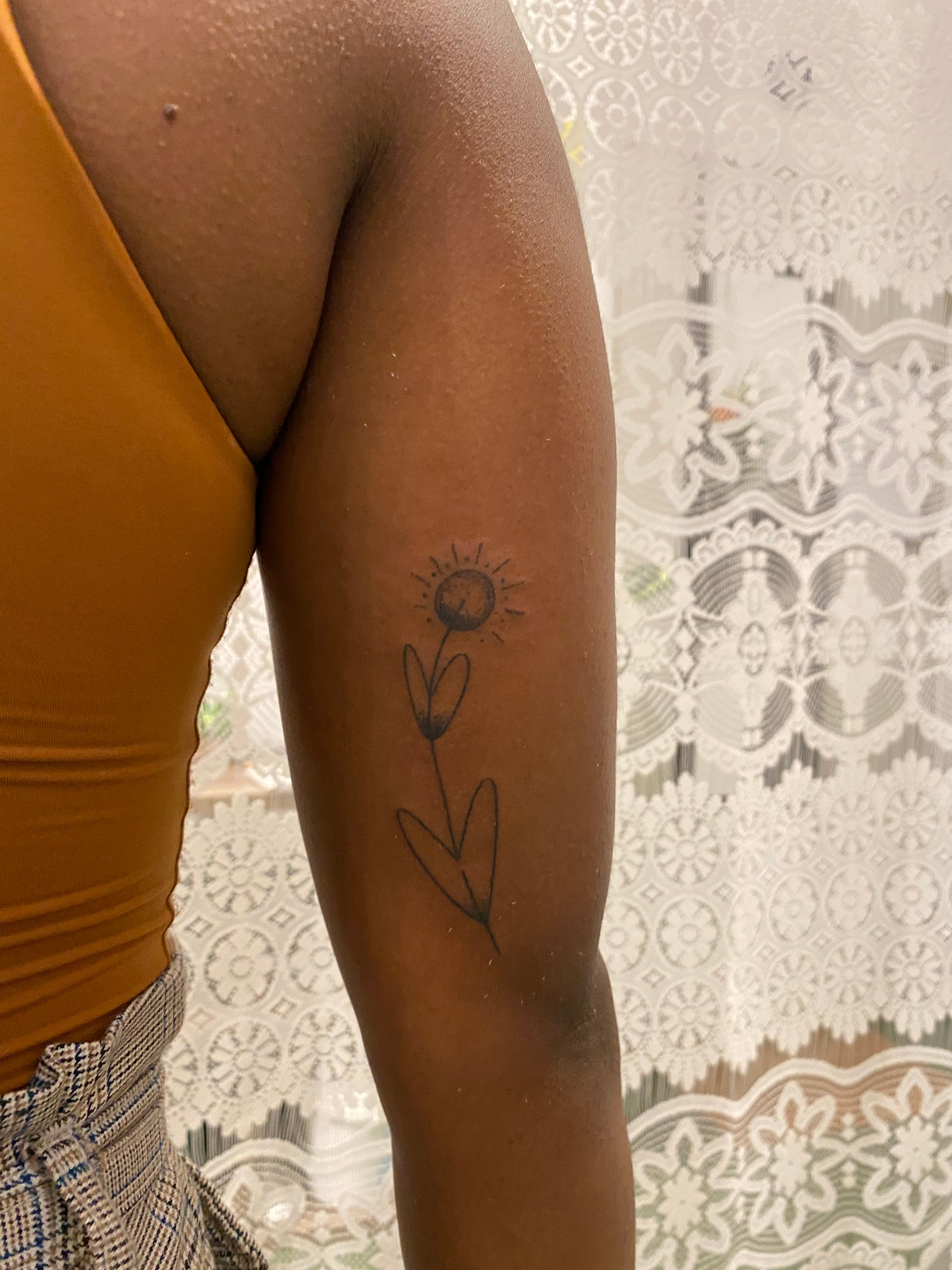‘White supremacy colors everything, even art’: Tattoo artists of color battle narrative that ideal skin for ink is white
Sezin Koehler had the perfect tattoo in mind. She imagined blue and purple swirls rising up her arm to match the colorful tattoos adorning her shoulders. After hours of planning and research, she brought her idea to a tattoo artist.
The artist took one look at her and said no.
“Your skin tone is a problem,” she remembers the artist telling her.
Koehler, 42, went to multiple artists, who said her skin was too dark to be tattooed in color. They suggested black and gray, even though Koehler already had blue and purple tattoos.
Each time, Koehler left the tattoo shops crying.
“Artists should be able to paint on any canvas,” said Koehler, a Sri Lankan and Lithuanian American culture writer from southeast Florida. “And if you can’t, there’s the internet, books, networks of artists that can teach you. If you wanted to learn, you could. So the fact is they’re making a choice that they only want certain kinds of people to tattoo. And that is racist. There’s no excuse for it.”
Racism manifests in the tattoo industry in different ways, experts told USA TODAY. Tattoo artists of color point to discriminatory hiring practices, racist or culturally appropriative imagery in tattoo designs, wage disparity, and a lack of respect given to tattooers of color.
As the industry faces internal calls to reckon with its own whiteness, many artists point to one major issue: a pervasive opinion that the ideal skin color to tattoo is white. Despite deep histories of tattooing in communities of color, tattoo artists say this myth persists, revealing racism and colorism within the industry.
Several artists of color told USA TODAY that tattooing darker skin is different from tattooing lighter shades. Darker skin often scars more easily, requiring the artist to shift to different areas and be gentler. Colors may also show up differently on darker skin, and layered color tattoos can sometimes take longer.
However, claims that dark skin cannot be tattooed in color or in certain styles requiring more detail are false, the artists said.
Lianna DeGuzman, a Filipino American tattoo artist in Oakland, California, said while this narrative has existed since the dawn of tattooing in the U.S., the issue has only come to light in the last few years, especially since the murder of George Floyd last year sparked calls across industries to examine systemic racism.
“This is a long overdue conversation,” she said. “People have gotten too comfortable discriminating against clients with darker skin and facing no repercussions.”
Protest Art: George Floyd’s murder generated outrage — and lots of soulful art
‘The smokescreens are now annihilated’: George Floyd. Trayvon Martin. Sandra Bland. For many Black Americans, these deaths and others have caused lasting trauma
A public lynching’: ‘Bernice King, Cory Booker, Julian Castro and other Americans reflect on George Floyd
Tann Parker (left), founder of Ink the Diaspora, and tattoo artist Quiara Capellan stand in their studio in Brooklyn, NY. (Photo: Robert Deutsch, USAT)
DeGuzman said it’s the tattoo artist’s job to educate themselves on all skin tones.
When tattoo artists aren’t trained in tattooing darker skin, she said they turn away clients, leaving them traumatized and perpetuating the “ideal skin tone myth.” Many artists and clients refer to this behavior as “skin shaming,” a microaggression.
Koehler said, due to skin shaming, she no longer goes to white tattoo artists and spends more time researching artists to see if they tattoo people of color.
“I’m just not going to risk being talked to like that anymore,” she said.
An artist who does fine line, detail work, DeGuzman said many of her clients have also been turned away by other white artists who say detailed tattoos are impossible on darker skin.
“It clouds their perspective on the tattoo world in general,” she said. “That traumatic experience lasts with them and leaves a lasting impression.”
The apprenticeship system for tattoo artists preserves the myth, DeGuzman said. White artists pass the narrative to apprentices in white-owned shops that already don’t frequently tattoo people of color.
Looking to get a tattoo? Artists say they’re seeing increased demand, despite the pandemic
Pandemic Tattoos: This man gives himself a new tattoo every day while home during the coronavirus pandemic
Can a work of art help end racism? Giant afro pick seeks to promote social justice
Quiara Capellan, an Afro Latina tattoo artist in Brooklyn, New York, said her clients of color often feel shy asking her for colorful and detailed tattoos because of previous experiences with white artists.
“When an artist says they can’t do it, it’s just that they don’t know how to do it,” she said. “And it’s not a reflection on the client. It’s a reflection on the artistry and skill level of the artist. There’s tons of artists who work on darker skin and know how to do color and detail work on those skin tones.”
In the past year, Capellan said she’s seen more Instagram pages highlighting tattoos on darker skin. But still, she said most of the feeds of tattoo artists she sees are lacking in diversity. Often, Capellan said artists desaturate their images so that their clients’ skin appears lighter in their portfolio.
“Lots of artists say it matches their aesthetic but why is this their aesthetic?” she said. “Why is your aesthetic erasing darker skin tones? At the end of the day, it’s colorism. It’s erasing someone’s Blackness or someone’s identity.”
A client models a tattoo done by Tann Parker, founder of the Ink Diaspora. (Photo: Tann Parker)
Tattoo magazines, media and TV shows perpetuate the narrative that white skin is ideal for tattooing, said Tyrone Cooley, a Black tattoo artist and owner of Tri-Cities Tattoo Company in Atlanta.
On the tattoo show, “Ink Master,” artists often avoid tattooing darker skin. In the show’s ninth season, one contestant said “That’s the one I wanted the least. How are you at tattooing really dark skin like that?” In the same season, a contestant referred to a “skin tone issue” with a Black couple.
“White supremacy colors everything, even art,” Cooley said. “They may not be conscious of the fact that they’re being racist, but it’s been hardwired into them. That’s how racism in America often works.”
The roots of tattooing are within “Black and brown communities,” Koehler said.
She said modern tattooing in the U.S. was co-opted from its roots in many Indigenous spiritual and cultural practices, and tattooing runs centuries deep in the histories of countries including India, Sri Lanka, Thailand, Japan, Egypt, Morocco, Ethiopia and many others.
“The industry is marginalizing the same people they stole these practices from,” she said.
Colonizers often showed a preference for lighter skin tones and embedded this colorism into the countries they colonized, Koehler said.
This idea of whiteness being the “default” has continued today in the tattoo industry and is also often the default skin tones for emojis, crayons and Band-Aids, said Kandace Layne, a tattoo artist at the Queen Bee Tattoo Parlour in Marietta, Georgia.
Layne said the word “dark” is so stigmatized that, with her clients, she uses words like “deep” or “heavily melanated.”
Dig deeper on race and identity: Subscribe to This Is America, USA TODAY’s newsletter
“Historically, a lot of businesses have decided not to work with Black people,” she said. “There was that explicit discrimination. When tattoo artists say they’re not going to tattoo someone because their skin tone doesn’t work with their style, to me, that means they’re still doing that. It’s heartbreaking that people don’t see that for what it is — discrimination, racism.”
But these artists have seen progress.
They’ve seen artists do free color tests to see how colors and inks heal on darker skin tones. And more artists are being transparent about wanting to learn to tattoo on darker skin.
Another beacon of hope many pointed to was Instagram pages celebrating tattoos on darker skin, including Ink the Diaspora.
Tann Parker, a Black tattoo artist who uses gender-neutral pronouns, created Ink the Diaspora in 2017 to inspire people of color to get the tattoos they want, despite what someone may have told them about how their skin isn’t ideal for tattooing. The page also helps connect people with artists of color and increase the visibility of these artists and their work.
“I always want to offer inspiration and hopefulness because I love all my tattoos, but to get to that point, you have to overcome some insecurities that this industry will put on you,” they said.
Simply put, white tattooers don’t hold all the information, even though they are often seen as the experts, Park said.
Other tattoo artists of color recommended tattooers swap white backgrounds on sample tattoo designs for different shades, stop filtering images to make skin look lighter and seek out training in tattooing darker skin. Several artists told USA TODAY that most synthetic practice skin only comes in lighter tones, so they recommend pushing for and buying practice skin in different skin tones.
While hiring more tattoo artists of color is a step in the right direction, Layne said she is reluctant to encourage shops to do this before they change their cultures from within.
“There’s a lot of internal work, and it has to come from a genuine place, not just not wanting to appear racist for fear of losing business,” she said.
Capellan worries most of the work in combating racism in tattooing falls on the shoulders of artists of color, rather than on white artists.
“Tattoo artists of color can’t make all the change on their own,” she said. “We’ve been fighting this fight for a long time.”
Contact News NOW Reporter Christine Fernando at [email protected] or follow her on Twitter at @christinetfern.
Source: Read Full Article



